 |
| Liberty Leading the People by Eugène Delacroix (1830) |
Eugène Delacroix’s Liberty Leading the People Painting
 |
| Self Portrait by Eugène Delacroix (1837) |
 |
| Portrait of Charles X by François Gérard (1825) |
Lady Liberty Leading the People of France, as La Marianne
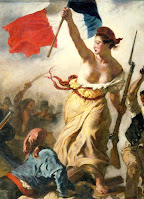 |
| Liberty Leading the People Detail of La Marianne |
 |
| Nike of Samothrace or Winged Victory of Samothrace (200-190 BC) |
The tripartite motto, liberty cap
, gallic rooster and French national
flags with three colors, are assumed as the parts of the big picture and
together they qualify a republican symbol
for French folk. Delacroix utilized Marianne
as the contemporary topic for a modern artisan and he handled the modern
subject from a different viewpoint, as a romanticist. However, persistence of
Marianne starts before the romantic painter. French illustrator Jean-Michel Moreau has painted the young woman in Greco Roman clothing, whom hanged her Phrygian
cap atop a spear. The illustration had been inspired by the Voltaire’s poem of Henriade
(1728). It was the first adoption of Roman
Goddess of Liberty as Marianne. It followed with La Liberté by Jeanne-Louise Vallain or commonly known as Madame Piètre in 1794, commemorating the First
French Revolution of 1789. Originally, Libertas was
one of the mother goddess figures in the history of art. Roman religion
promotes her onus as personal freedom and liberty among roman statues.
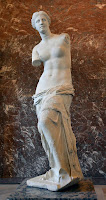 |
| Venus de Milo by Alexandros of Antioch (150-125 BC) |
 |
| La Liberté by Nanine Vallain (1794) |
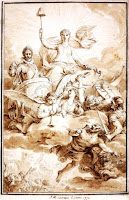 |
| La Marianne by Jean-Michel Moreau (1775) |
Marianne’s florid face with red cheeks and
plump lips
support the claim that she has been attributed some features of Aphrodite.
Her bare breasted rallying call for rest of the rioters, symbolize not only
independence but the future of France over fertility concept in art, from a
unique point of view. Contrary to the idealism in
Hellenistic Period sculptures carved with aesthetic
concerns aiming purity, Lady Liberty is faraway from this antiquity with her fierceness and vulnerable existence.
She stands for a symbol of resistance for both rioters and the artist himself.
Visual arts of Renaissance generally base upon perfectness and elegance.
 |
| The Pietà by Michelangelo (1498-1499) |
 |
| The Birth of Venus by Sandro Botticelli (1485-1486) |
 |
| Sistine Chapel Ceiling by Michelangelo (1508-1512) |
 |
| Venus with a Mirror by Titian (1555) |
 |
| Venus and Amor by Hans Holbein the Younger (1526-1528) |
 |
| John Constable by Daniel Gardner (1796) |
 |
| Self Portrait by Joseph Mallord William Turner (1799) |
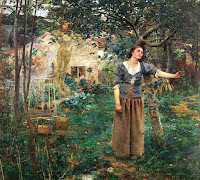 |
| Joan of Arc by Jules Bastien-Lepage (1879) |
Her devotion for the
Catholic
Church and its religious doctrines, have been portrayed countless time through
art periods from High Renaissance to Naturalism. Jules Bastien-Lepage’s Joan of
Arc painting is one of the late modern period depictions of French saint, while
Trial of Joan of Arc by Paul Delaroche contains highly baroque style art
values, however both artists have been shared Romantic Era. She has not been
only depicted as a woman with idealized beauty but the passion of Joan of Arc
for her cause, was a great topic for a viraginian figure and its triumph pose.
Although paintings of Jeanne d’Arc show similarities with
another woman hero
La Marianne via leadership qualification and the feature of being a prime for
their own phase, mannerism and baroque artworks of Jeanne d’Arc exhibit a
beautiful lady without any vulgar details but full of personal piety and
excellence, inversely Lady Liberty. In this sense, Lady Liberty’s symbolism and
uniqueness are second to none among history paintings.
 |
| Trial of Joan of Arc by Paul Delaroche (1797-1856) |
 |
| The Life of Joan of Arc Triptych by Hermann Stilke (1843) |
 |
| A Sans-culotte with a Halberd by Lesueur Brothers (1794) |
 |
| Women of Algiers in their Apartment by Eugène Delacroix (1834) |
 |
| The Massacre at Chios by Eugène Delacroix (1824) |
| Portrait of Olympes de Gouges by Alexander Kucharsky (1748) |
 |
| Magna Carta Libertatum signed by King John of England (1215) |
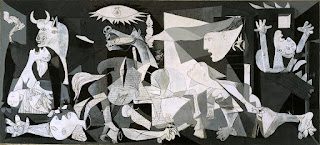 |
| Guernica by Pablo Picasso (1937) |
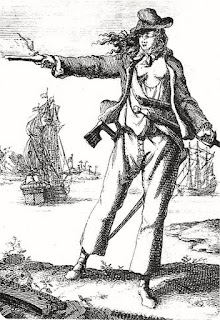 |
| Illustration of Anne Bonny in the Book of Charles Johnson (1724) |
 |
| Idealized Sans-culotte by Louis-Léopold Boilly (1761-1845) |
 |
| French Euro Coins with La Marianne (1983) |
Liberty Leading the People Analysis
 |
| The Death of Marat by Jacques-Louis David (1793) |
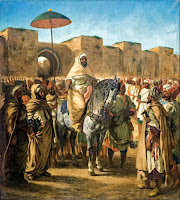 |
| The Sultan of Morocco by Eugène Delacroix (1845) |
The French Cuirassier in Liberty Leading the People
 |
| Liberty Leading the People Detail of French Cuirassier |
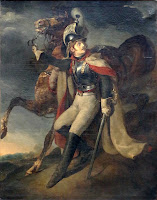 |
| The Wounded Cuirassier by Théodore Géricault (1814) |
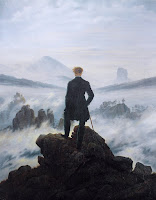 |
| Wanderer above the Sea of Fog by Caspar David Friedrich (1818) |
 |
| Chalk Cliffs on Rügen by Caspar David Friedrich (1818) |
The Swiss Guard in Liberty Leading the People
Liberty Leading the People reveals
another fallen soldier next to cuirassier, a swiss national guard armed with cream
pants and blue top, indicates fraternity. Along with Swiss Guards regiments had
served to many European courts for different periods of time, first establishment
of them to French Court as the Hundred Swiss, coincides the years between 1490
and 1817. Although most known use of them is in Vatican City as Papal Swiss
Guards, this class has been utilized by Napoleon and the Bourbon Restoration
too. His white torn socks are obvious under the loose fitting trouser.
 |
| Liberty Leading the People Detail of Swiss Guard |
 |
| Storming of the Bastille by Jean-Pierre Houël (1789) |
 |
| 2017 Bastille Day Eiffel Tower, Paris |
 |
| Capture of the Tuileries Palace by Jean Duplessis-Bertaux (1793) |
 |
| The Blue Room by Pablo Picasso (1901) |
The Hector alike Man in Liberty Leading the People
Liberty Leading the People painting tells
same
misery standing for the half naked man in white shirt next to the Swiss
soldier. The poor guy lying down on his back, represents sacrifice and wild
nature of revolutions. The best guess about the prominently located area
covered by his presence is that the artist felt need to impress the observers
due to large canvas size. His dark red hair color and a piece of blood on the
waist region, address to the red part of French national flag, while other
primary colors are completed with blue sock and white top. The man was probably
dragged out of the bedroom of his home in the middle of the night by royalist
soldiers or some supporters of the crown. The only clothes of the murdered man
are a single blue sock and a white long sleeve shirt what people wear in night.
While blue socks may represent luck according to community, art historians
indicate that his pose evoking a heroic failure against Achilles that Prince
Hector in Troy had in story of the Iliad and Odyssey by Homer.
 |
| Liberty Leading the People Detail of Hector alike Man |
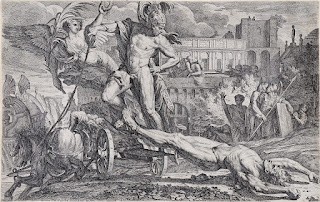 |
| Achilles Dragging the Body of Hector by Pietro Testa (1612-1650) |
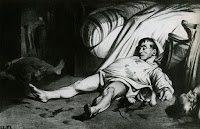 |
| Transnonain Street by Honoré Daumier (1834) |
 |
| Achilles Dragging the Body of Hector around the Walls of Troy by Gavin Hamilton (1775) |
 |
| King Priam Pleading for the Body of Hector by Gavin Hamilton (1775) |
The Young Infantry in Liberty Leading the People
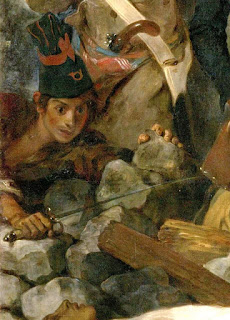 |
| Liberty Leading the People Detail of Young Infantry on Cobblestones |
The young guy wears a redshifted brown shirt and
some bodily parts of him have been cut by the artist in order to create a
holistic approach. Same condition stands for the cuirassier at the far right of
the painting. Delacroix’s enthusiasm in creative arts and new approaches, as
the factors made him one of the fathers of Romanticism, have pushed him to
create a scene, which is designed to display its story from the perspective of
human eye. In the middle of this catastrophic event, City of Paris has no
social order. While day laborers, nobles and the class of petit bourgeois
create a beautiful chaos with fallen ones under the flag of French
Revolution, the young infantry contributes to the sociocultural diversity.
The Boy as the Inspirer of Gavroche, Les Misérables
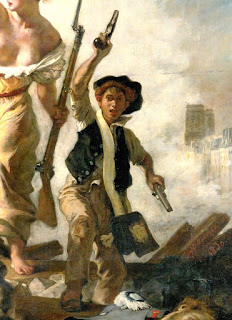 |
| Liberty Leading the People Detail of Gavroche |
 |
| Illustration of Gavroche in Les Misérables by Émile Bayard (1837-1891) |
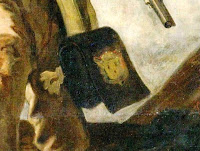 |
| Liberty Leading the People Detail of Embroidered Bag |
 |
| Heraldic Shield of Bourbons (1815-1830) |
 |
| Bourbon Restoration Flag with Three Golden Insignia (1815-1830) |
 |
| Influence of Gavroche on the Last Moments of Butch Cassidy and the Sundance Kid Movie (1969) |
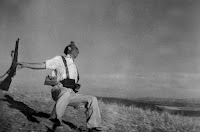 |
| The Falling Soldier by Robert Capa (1936) |
The Wearied Figure in Liberty Leading the People
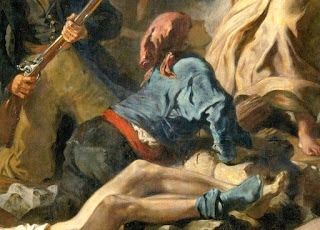 |
| Liberty Leading the People Detail of Wearied Figure |
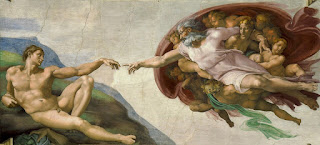 |
| The Creation of Adam by Michelangelo (1512) |
In an
aerial perspective, his presence is as significant as La Marianne and Gavroche,
in contrast with busy scene that covered with plume of smoke around the main characters.
While, the young worker wounded next to La Marianne contributes to the
different types of diversity based on main figures in the romantic painting,
the scene that they look at each other reminds The Creation of Adam by Michelangelo
in Sistine Chapel. The artist depicts one of the watershed moments in July
Revolution that leads bad mood rising from the view of observers via
spiritualism and the symbolic star of the painting, Lady Liberty and her
characteristics of Renaissance.
Eugène Delacroix Self Portrait in Liberty Leading the People
 |
| Liberty Leading the People Detail of Eugène Delacroix's Self-Portrait |
 |
| Liberty Leading the People Detail of Knotted Scarf |
 |
| Portrait of Charles-Henri Delacroix by Eugène Delacroix (1800-1845) |
 |
| Portrait of Duchess of Berry by Sir Thomas Lawrence (1825) |
 |
| The Battle of Nancy and the Death of Charles the Bold by Eugène Delacroix (1831) |
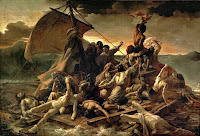 |
| The Raft of the Medusa by Théodore Géricault (1819) |
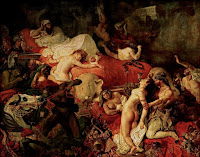 |
| The Death of Sardanapalus by Eugène Delacroix (1827-1844) |
 |
| Self-Portrait by Peter Paul Rubens (1623) |
 |
| The Starry Night by Vincent van Gogh (1889) |
 |
| Self-Portrait with Spectacles by Francisco Goya (1801) |
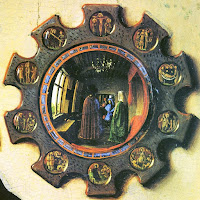 |
| The Arnolfini Portrait Detail of Convex Mirror and Jan van Eyck |
Every Painter Paints Himself
 |
| Self-Portrait by Francis Bacon (1973) |
 |
| Portrait of Dante Alighieri by Sandro Botticelli (1495) |
 |
| Portrait of Michelangelo by Daniele da Volterra (1545) |
The Factory Worker in Liberty Leading the People
Liberty Leading the People presents a
brightly
colored man in working apron, who is a contemporary builder, as a person of low
degrees for the old world.
His face reviving the anger is lack of politeness,
contrary to Lady Liberty reminding classical sculptures
like statue of Aphrodite. As a temporary construction labor, the artists completed
his figuration properly for the french
culture. The figure depicted highly white pattern,
carries a brown felt cap with white cockade and red ribbon. His blue and red
handkerchief with the white stripes, separate him from the upper class including
the man in black tuxedo suit next to him. He participated the life changing
event of July Revolt and shares the emotional response with angry mob. The
laborer holds a briquet, which is a french word
meaning a type of saber packed by military
classes in Napoleonic Wars during the First
Republic.
 |
| Liberty Leading the People Detail of Man in Working Apron |
 |
| Scene of July 1830 by Léon Cogniet (1830) |
Liberty Leading the People Background Characters
Liberty Leading the People
reveals that
some of the revolutionaries stood in
the background of the picture plane. July Rebellion was the civil commotion
that has been participated by the people from
all walks of life. They are three fighters and different
types of people, whose faces are in sight among other rioters. Their presence
evokes the color of the French flag and social diversity. There seems tools and
muskets are rising upon their head and shoulders. The foremost man is possibly
a former infantry and one of the political prisoners released during the Fall
of Bastille. He wears a white shirt and light taupe coat paired with the golden
color of the hilt of his sword. The guy stands for the vanguard move of sans culottes
in Three Glorious Days.
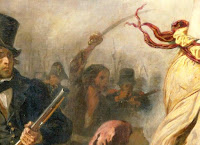 |
| Liberty Leading the People Detail of Three Revolutionaries |
 |
| Liberty Leading the People Detail of Revolutionist under French Flag |
Towers of Notre Dame Cathedral in Liberty Leading the People
Liberty Leading the People shows
the
bell towers of Notre Dame Cathedral. The architectural monument of Paris, are
in sight through white canon fog. The famous cathedral in Paris has been an art
subject for many greatest painters of all time, such as Vincent van Gogh and
Henri Matisse. The painting reveals a very small picture of French flag
flapping on the tower of Notre Dame, stressing its distinct colors of red,
white and blue. With that, the number of French tricolore flags in the romantic
painting is three. At the bottom side of notre dame background, there is a
group of grenadiers in military formation and depicted in details. By this
image, Eugène Delacroix expresses that the conflicts had
happened at the heart of paris close to Notre Dame. The use of elements and
artist’s imaginative approach are absolute due to that the masterpiece is not a
simple nature painting. Liberty Leading the People is full of allegory and
reality at the same time.
 |
| Liberty Leading the People Detail of Notre Dame Cathedral |
Lady Liberty as the Inspirer of the Statue of Liberty, NYC
 |
| The Statue of Liberty by Frédéric Auguste Bartholdi and Gustave Eiffel (1886) |
Liberty Leading the People Influenced Covers of Albums and Books
Liberty Leading the People
and
Delacroix not only changed contemporary
art movements during his lifetime. The artist also influenced the direction of
all art movements that came after him including music and literary. The impacts
of romantic painter were obsolete in the novels and poems of contemporary
writers of the Romantic Era poetry. Théophile Gautier, Charles Baudelaire and
Paul Armand Silvestre are some of those romantic writers. Besides romantic
writing, there remains famous books by modern artists, covered by Delacroix’s
famous painting. “The Age of Revolutions” by Eric Hobsbawm and “The Future of
Freedom: Illiberal Democracy at Home and Abroad” by Fareed Zakaria, reveals fascinating
books covers referencing the romantic work. In music industry, contemporary
design of painting is highly utilized in both classical and alternative music.
“Symphony No. 6, ‘After Delacroix’: III Allegro” by George Antheil and famous
British rock band Coldplay’s Viva la Vida or Death and All His Friends, are the
examples of painter’s influence on music genres. Likewise, André Suarès say;
“The whole of modern art issues from Delacroix”.
 |
| Viva la Vida by Coldplay (2008) |
Delacroix’s Notes About Liberty Leading the People
 |
| Portrait of Charles de Verninac by Eugène Delacroix (1825-1826) |
Movements and World Events Influenced by Liberty Leading the People
 |
| Photograps from Gezi Park Protests Barricade (2013) |
 |
| Photograps from Gezi Park Protests Lady in Red (2013) |
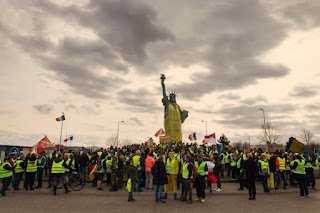 |
| Photograps from Yellow Vest Protests Detail of French People |
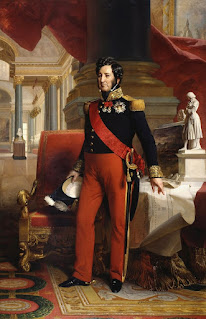 |
| Portrait of Louis-Philippe I by Franz Xaver Winterhalter (1841) |
 |
| Liberty Leading the People Mural by Pascal Boyart after Delacroix |
 |
| Arc de Triomphe Le Champs-Élysées Avenue |
 |
| Liberty Leading the People Detail of Eugène Delacroix's Signature |
 |
| Mona Lisa by Leonardo da Vinci (1503-1507) |
Details like roman toga and straight nose identifying the
Roman posture of La Marianne and the shades of red pattern utilized in several
segments of Boyart’s graffiti art, originates Delacroix’s masterpiece as one of
the most famous paintings in the Louvre with Mona Lisa, while safety glasses, biker apparels due
to hi vis vests and black berets, refer to the additions of french artist, who blends
two different art styles and patriotic acts in art world. The people, who
defined themselves as Gilets Jaunes in french, worked for financial and social
justice, and their effort inspired nearby countries in Europe. Not only
Boyart’s mural in Paris, but photography and digital arts including digital
drawing and photoshop backgrounds, gathered Yellow Vest Movement and Liberty
Leading the People many times.
Liberty Leading the People Facts
 |
| Greece on the Ruins of Missolonghi by Eugène Delacroix (1826) |
Liberty Leading the People by Eugène Delacroix
 Reviewed by Articonog
on
January 29, 2022
Rating:
Reviewed by Articonog
on
January 29, 2022
Rating:
 Reviewed by Articonog
on
January 29, 2022
Rating:
Reviewed by Articonog
on
January 29, 2022
Rating:




No comments: